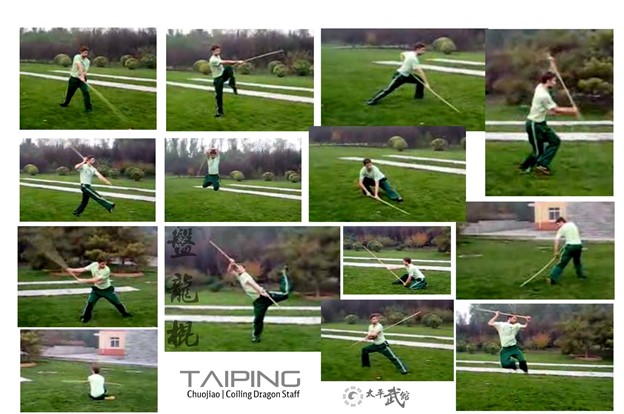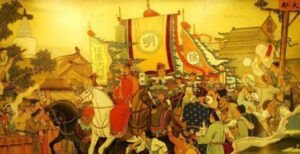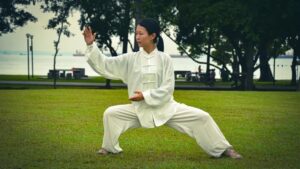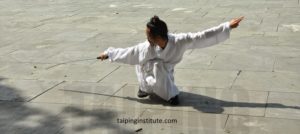In thousands of years of history, great strategists and practitioners of military skills have appeared in China. There are cultural heritages that are rare and in many cases even lost. One such special set of practices is concerned with the Staff. A simple yet highly dynamic weapon, the Staff is thought to be the easiest yet one of the most powerful weapons. In Chinese Martial arts there is a saying “Spear Strikes in a line, The Staff Sweeps in a large area”.
Song Taizu, the legendary Patriach of the Wuhu Panlong Staff
Zhao Kuangyin 927-976, the First Emperor of the Song dynasty was said to leverage his staff when fighting for the various states/provinces and helped him become the leader of a Dynasty. Wuhu Gun (五虎棍 Five Tigers Staff) is originally known as Wuhu Panlong Gun (五虎盤龍棍 Five Tigers Coiling Dragon Staff), and sometimes as Wuhua Gun (無花棍 Flowering Staff). It was said that before Zhao ascended the throne, Zheng Ziming had defeated the five tigers of the Dong Family. Many generations this staff had been passed down in the Xinzhuang village of Hejian County, Hebei Province. It was said that throughout its over 600 year history, the practice came to consist of over 420 postures/techniques, which today has basically become extinct, no longer found. Feng Keshan had studied the boxing (Taizu Changquan and Bafanquan) and some weapons from Hejian, considered the likely origin of this staff. There is however, a legend that Zhao Kuangyin had received the staff method from a Daoist on Hua Mountain.
Yu Dayou 俞大猷 , inheritor of Taizu’s staff
Based on the great achievements of Yu Dayou 俞大猷 (1503-1579) in Southern China, it was thought that in Northern China much of the Staff methods were lost. In the Ming Dynasty, Famous Hero General Yu Dayou, who wrote the Sword Classic (actually its about the staff), together with General Qi Jiguang were known as “Dragon Yu and Tiger Qi”, also during the time Yu Dayou earned the ‘Best staff under heaven’ for his Yu Family Staff methods. Yu Dayou however had learnt from Li Langqin (whose real identity was surnamed Zhao, a descendant from the Royal family of the Song), thus the staff Li taught Yu Daoyou were parts from the Taizu Staff, which was the methods from Song Taizu Zhao Kuangyin (ie Five Tigers Staff 五虎棍 ).
Today, many people have tried to study from Yu Dayou’s manual but many of the interpretations are quite incorrect. Shaolin Temple has a set called Yu Family Staff thought to be from the time Yu Dayou taught the monks for a few years but that is quite incomplete practice. The remnants of Yu Dayou’s staff are found in the Staff methods of Fujian Zhangzhou Taizuquan and associated southern martial arts of Min Nan and Ling Nan. In the North however the direct transmissions of Song Taizu staff are found in styles in Gansu, Shanxi and Hebei.
Feng Keshan, inheritor of the Coiling Dragon staff
Chuojiao Master Feng Keshan 冯克善 (~1776~1858), was one of the greatest martial artists in history. He had acquired many martial arts systems throughout his life, be it via his masters, students, teachers, rebellious brothers or otherwise. He had both the talent and the intelligence to master the most important of combat arts and had passed much to his descendants, each often achieving a part of the great knowledge he held. Further many of the methods were also from his disciples and fellow rebels, since they had prior training in other martial arts before studying with Feng. Although within Chuojiao there are many specific staff methods such as Open the Mountain Staff 開山棍 , Yinyang Locking hands Staff 鎖手棍 and Mother Son Staff 子母棒 . The Wuhu Panlong Gun (The Five Tigers Coiling Dragon Staff | 五虎盘龙棍), also known simply as Panlong Staff, is the most comprehensive staff method, and was rarely transmitted within the Chuojiao system as it is known and practiced by few.
Overview of the Method
The Panlong Gun of Chuojiao consists of Five Sequences with over 135 Postures/methods, where each posture often consists of a number of techniques/moves. Within each of the five sequences there are special techniques that are included which are unique to the sequence. Unlike modern created sets, this Panlong Gun has specific poetic traditional names for all its methods. As an example in the first sequence there is the Young Prince Fishing, Phoenix pecking, the Dragonfly hovering over water, Green Dragon spitting out water and so on. The first sequence being the foundation, as the remainder are arranged in ascending order of difficulty. There also a 3 sectional staff set attached within the Five Tigers Coiling Dragon Staff system. One of the important principles within the method is that techniques are hidden while the staff and the stepping is moving, this results in spinning circular staff methods that are changing angles, defending and attacking and simultaneously which when analyzed carefully are hiding a multitude of techniques.
The traditional process of Panlong Gun study consists of:
1. Understanding and mastery of the individual staff methods which consists of 32 different basic staff actions. These include Point, return, close, spread, chop, poke, press, hook, sweep, block, wrap, lift, and so on.
2. Practising those methods in short sequences (formal stick techniques) as to the type of stick formation, such as single end, double end and interlocking together with variations of footwork and entry.
3. Practising the methods with a partner to allow the right feel for the basics but also understand the power and body methods necessary to support the staff methods. If the stepping, body and power are not aligned the methods are not as useful so this is an important process.
4. Study the key methods within Panlong (on both sides) and include the systematic combat variations. These methods are not just stick combinations like in (2) but classical inter-looped techniques that contain combat principles and strategy together with the techniques.
5. Learn the arrangement of the methods into the Panlong Staff Set and taught in sections according to the specific focuses of each.
6. Practice combinations unto freely being able to apply the stick naturally in combat.




